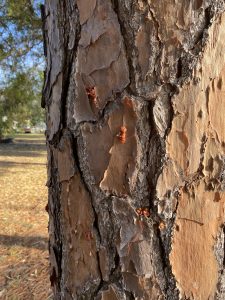Pine Bark Beetles are an ever-present issue in both the urban and rural landscape across the Panhandle. If you have pines in your landscape you very well may experience issues with pine bark beetles. The tiny insects can decimate a pine rather quickly, and there are more than one type that can infest a tree. The Southern Pine Beetle is the bark beetle that most people are familiar with and most concerned about. In forestry settings the Southern Pine Beetle can have epidemic outbreaks that can devastate large areas of pine forests and plantation. While the Southern Pine Beetle is very destructive and a concern to forest health, there are other common pine bark beetles that often attack trees in our area. The two other common bark beetles are Ips pine engraver beetles and Black Turpentine Beetles. In urban settings these two beetles often are more common but they can easily wipe out several trees or more, which may pose a significant issue in the landscape.

Resin pitches on bark that indicate pine bark beetle infestation. This shows a pine that is actively colonized by bark beetles and should be removed.
Photo Credit-Ian Stone
There are multiple species of Ips beetles and these tend to be a significant issue in landscapes, because they can easily wipe out most of the trees in a yard or park. They almost always target stressed or damaged trees, but they usually do not wipe out large areas like Southern Pine Beetle. Different Ips species will often attack different portions of the tree which can result in partial dieback of the crown or a slow yellowing and browning of the foliage. These beetles are very small, smaller than a grain of rice, and often are not seen readily without close inspection. Like other bark beetles the bark will often have resin oozing out and forming small pockets resembling popcorn. Other signs include yellowing and browning foliage and an accumulation of sawdust like material around the base. You may also see exit holes in the bark about the size of a pencil lead.
The Black Turpentine Beetle is closely related to the Southern Pine Beetle, but much larger and often attacks the lower portion of the tree. These beetles commonly attack older, damaged, and weakened trees. Historically they were often associated with turpentining operations and trees that had been worked for resin production, hence their common name. They are very attracted to trees that are damaged by equipment or that have had construction occur around them recently. The symptoms are generally the same as other pine bark beetles, but the resin pitches are larger and the exit holes are about the size of an eraser. While they are larger than other bark beetle they are still quite small by comparison to other insects, not much larger than a grain of rice and somewhat smaller than a pea.
If you notice pines in your area with bark beetle symptoms it is natural to be concerned. As the weather warms bark beetle activity increases and you may notice these symptoms on your pines. If you had bark beetles attack a tree in your yard last year you will want to keep an eye out for other pines being attacked in the spring. With the drought last year bark beetle activity increased and if the infected trees were not removed spots may reactivate in the spring and summer. Unfortunately, once bark beetles attack a pine there is really nothing to do other than removal. Insecticides and sprays will not do anything against bark beetles that are already in the tree. If you have high value pines in your landscape you want to preserve, prevention is key. First and foremost avoiding issues from equipment damage and construction is key as this will attract beetles. Preventative injections with systemic insecticides by a licensed professional can protect trees in your landscape. If you have noticed bark beetle activity in the area or have had to recently remove trees that died from bark beetles, consider preventative treatment to preserve trees that are at risk. Otherwise removing trees that become infested with bark beetles promptly is the best solution. Sometimes it can be difficult to determine what trees to remove, but any trees showing active bark beetle activity should be removed to prevent spread. Once bark beetles have colonized a tree and it is in decline preventative insecticide treatments are not going to be effective. You also don’t need to remove every pine in your landscape just because a single tree has bark beetles. At the following link you will find an IFAS EDIS article that is helpful in identifying bark beetles and making a decision about an infected tree https://edis.ifas.ufl.edu/publication/FR399.
If you see bark beetle activity on your property this spring contact your local IFAS extension office or your Florida Forest Service County Forester’s office for assistance and information. A Certified Arborist can assist you with determining how to remove infected trees or apply preventative treatments to trees at risk. With good decision making and management pine bark beetle attacks can be managed before they grow and spread. Now is a good time to keep an eye out and get ahead of any infestations that start.
- Pro-Tips for Dealing with Problem Oaks and Other Brush in the Home Landscape - November 21, 2024
- Elderberry: A Very Attractive and Useful Native Plant - June 20, 2024
- Pine Bark Beetles – With Warming Weather Comes More Activity - May 9, 2024
